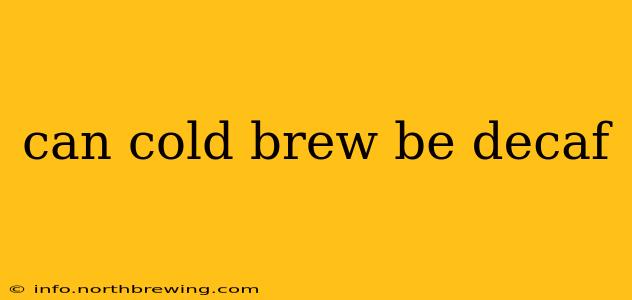Cold brew coffee, with its smooth, low-acidity profile, has taken the coffee world by storm. But what about those who enjoy the chilled brew but prefer a decaffeinated option? The simple answer is: yes, cold brew can absolutely be decaf. However, understanding how decaf cold brew is made and what to look for when purchasing it is key to enjoying the best possible experience.
How is Decaf Cold Brew Made?
The process for making decaf cold brew is similar to regular cold brew, but with a crucial initial step: decaffeination. Green coffee beans are decaffeinated before they're roasted. Several methods exist, including:
- Swiss Water Process: This method uses water to extract caffeine, leaving behind the coffee's flavor compounds. It's considered a "clean" method, leaving minimal chemical residue.
- CO2 Process: Supercritical carbon dioxide is used to extract caffeine. This is also a relatively clean method, though some argue it can subtly affect the flavor profile.
- Ethyl Acetate Process: This method uses ethyl acetate, a naturally occurring compound also found in fruits, to remove caffeine. While effective, some coffee purists prefer other methods due to potential residual flavor changes.
- Methylene Chloride Process: While effective, this method is less common due to concerns about chemical residues, although modern processes minimize any significant impact.
Once the beans are decaffeinated, they are roasted and then used to make cold brew coffee using the standard cold-brew method: coarsely ground beans steeped in cold or room-temperature water for 12-24 hours. The resulting concentrate is then diluted with water or milk before serving.
Does Decaf Cold Brew Taste Different?
The taste of decaf cold brew can vary depending on the decaffeination method and the quality of the beans used. Some people find that decaf cold brew has a slightly different flavor profile than its caffeinated counterpart, often described as being slightly milder or less intense. However, with high-quality beans and a careful decaffeination process, the difference can be minimal. Many factors contribute to the taste beyond decaffeination, including the bean origin, roast level, and brewing method.
What are the Differences Between Decaf and Regular Cold Brew?
The primary difference is the caffeine content, of course. Regular cold brew contains caffeine, while decaf cold brew has significantly reduced levels of caffeine. Aside from that, the brewing process is mostly identical, leading to similar textures and body, but subtle differences in flavor are possible based on the decaffeination method.
Is Decaf Cold Brew Healthier Than Regular Cold Brew?
Decaf cold brew isn't inherently "healthier" than regular cold brew. Both can be part of a balanced diet. The advantage of decaf is primarily for those sensitive to caffeine or who wish to avoid it for personal reasons.
Where Can I Buy Decaf Cold Brew?
Decaf cold brew is increasingly available at coffee shops, grocery stores, and online retailers. Look for brands that specify their decaffeination method to ensure transparency and quality. You can also make your own decaf cold brew at home using decaffeinated coffee beans.
Does the decaffeination process affect the cold brew’s taste?
The taste can be affected, although high-quality decaffeination methods minimize this impact. Some people report a slightly different flavor profile – often described as milder or less intense – while others find the difference negligible, especially when high-quality beans and a precise brewing method are employed. The type of bean and roast also contribute significantly to the final taste.
In conclusion, enjoying a delicious and smooth decaf cold brew is entirely possible. By understanding the decaffeination process and choosing high-quality beans, you can savor all the delightful aspects of cold brew without the caffeine.
